Trades of Hope promises you the opportunity to pursue unlimited income potential while helping artisan mothers in impoverished areas of the world. But, is Trades of Hope a good opportunity or just another MLM exploiting its distributors? Here’s what you need to know.
Is Trades of Hope a good opportunity? Because Trades of Hope willfully withholds the total cost of their program and how much the average Compassionate Entrepreneur earns, we are left to assume it is not a good opportunity.
When you look past the relentless emotional marketing, you’ll discover that Trades of Hope is not what it appears to be. Here’s what we found.
Click to Discover a Proven Path to Financial Independence!
Is Trades of Hope a Good Opportunity?
Trades of Hope has masterfully combined the emotional appeal of helping impoverished women with the exploitative business model multi-level marketing.

That’s a good thing for the Trades of Hope money machine that generates millions in revenue each year, but not so much for the rank and file Compassionate Entrepreneurs, aka independent salespeople, who foot the bill.
The Trades of Hope sales pitch is like a mashup between giving to a charity and making money. Those are two very powerful attractors.
Unfortunately, Trades of Hope fails to mention how much the company is profiting at the expense of their Compassionate Entrepreneurs.
When you look past the emotional appeal, you discover Trades of Hope is just another MLM where most distributors spend more buying the company’s products than they make with the opportunity.
For all its feel-good messages of empowering women, Trades of Hopes keeps a lot of secrets.
As a Direct Selling Association member, Trades of Hope is required to provide all the information a person needs to evaluate the opportunity.
Trades of Hope willfully withholds the information needed to make an informed decision about its opportunity.
The Trades of Hope Compensation Plan is NOT an income disclosure.
The compensation plan is a hypothetical projection of what someone MIGHT earn if they meet all the requirements. The income disclosure is a historical record of what the Compassionate Entrepreneurs DID earn.

Before we can realistically evaluate the Trades of Hope business opportunity, we must have access to the average earnings of their sales force and the total cost of the opportunity.
You won’t find this information anywhere on the Trades of Hope website or anywhere else online.
Specifically, we need to see an Earnings Disclosure Statement showing the average earnings of each sales rank and how long it takes to reach that rank.
We also need to know how much the opportunity will cost, not just the cost of the starter kits, but also the cost of “qualifying” each month.
As you’ll see in a moment, the cost of “qualifying” is obscure.
Trades of Hope has this information. It’s required by the Internal Revenue Service and the Federal Trade Commission. There is a reason Trades of Hope isn’t making the information public.
In its Code of Ethics, the Direct Selling Association requires members to publish all the necessary information to make a reasonable decision about the company’s business opportunity.
requires members to publish all the necessary information to make a reasonable decision about the company’s business opportunity.
Why doesn’t Trades of Hope published how much their Compassionate Entrepreneurs earn?
Perhaps if people knew the truth, they would not join Trades of Hope.
To survive, Trades of Hope needs a steady influx of new salespeople buying starter kits and products. That’s how the MLM business model works.
Without continuous fresh blood, Trades of Hope will die.
Because Trades of Hope does not publish the average earnings of its salespeople, we are forced to use the average of the MLM industry.
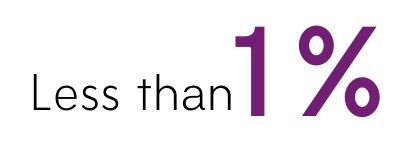
According to research published on the Federal Trade Commission’s website, less than 1% earn a profit with MLM.
In other words, 99% of the people who try MLM lose money. For most people, MLM is NOT an opportunity; it’s a liability.
Click to Discover a Proven Path to Financial Independence!
What You Need to Know about Trades of Hope.
Remember, for all of its feel-good marketing, Trades of Hope is a privately owned, for-profit company. It wasn’t created to help you make money. It was created for YOU to help THEM make money.
If the founders of Trades of Hope genuinely wanted to empower women, they would not use the MLM business model. By design, the MLM business model does one thing very well.
It takes money from the distributors, aka Compassionate Entrepreneurs, and funnels it into the company’s coffers and into the pockets of a few people at the top of the sales organization who got in early.
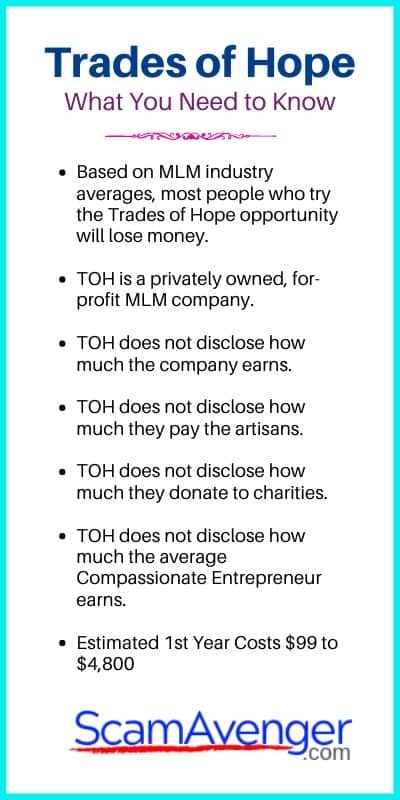
Make no mistake, MLM can be extremely profitable for the company. Unfortunately, these profits come from the people in the sales force who buy most of the products.
MLM pushes most of the company’s operating expenses onto their salesforce while at the same taking most of the profits.
Trades of Hope does not disclose how much the company earns each year.
An online search revealed that in 2015, Trades of Hope expected to earn $8 million and was said to be growing at 300% a year. (Source: DirectSellingNews.com)
Trades of Hope also does not disclose how much they pay the artisans who make the products. It merely states that artisans are paid what they ask.
How much would a poor mother in Haiti ask for a necklace she made when most people in Haiti live on less than $2 a day?
And how much does Trades of Hope sell that necklace for? $30? $50?
What You Need to Know.
- Trades of Hope is a privately owned, for-profit MLM company.
- Trades of Hope does not disclose how much the company earns.
- Trades of Hope does not disclose how much they pay the artisans.
- Trades of Hope does not disclose how much they donate to charities.
- Trades of Hope does not disclose how much the average Compassionate Entrepreneur earns.
- Estimated 1st Year Costs $99 to $4,800
- Based on MLM industry averages, it is estimated that most people who try the Trades of Hope opportunity will lose money.
Trades of Hope Compassionate Entrepreneurs.
Trades of Hope calls its distributors Compassionate Entrepreneurs (CE).
To become a CE, you must purchase a starter kit for either $99 or $199.
A starter kit permits you to sell products and earn a 20% commission on what you sell. You must sell a minimum of $150 worth of products each year to remain active.
However, beyond this basic level, things begin to get very expensive, as we’ll see in a moment.
Step Back and Think.
If you’re considering the Trades of Hope opportunity, it’s essential to clearly think about what it will cost and what you hope to get in return.
First, realize that the only reason you are aware of Trades of Hope opportunity is that someone is trying to sell it to you. They stand to benefit if you join.
By design, MLM exploits personal relationships.
If you have an analytical mind, you’ll naturally see past the Trades of Hope emotional façade.
However, for most of us, it’s a little trickier.

That’s why you must think like a businessperson. You must be as objective as possible. Let the facts speak for themselves.
Where Trades of Hope hides the information, assume the worse.
Also, at every step, think about what you might lose. If you lost everything you invested in Trades of Hope, could you cope?
Or would it be devastating?
Losing everything AND going into debt is a real possibility.
Remember, if you pass on the Trades of Hope opportunity and later change your mind, it will still be there. On the other hand, if you go all in and regret it, you may never get your money back.
Making the wrong decision here can leave you in debt, humiliated, and alienated from family and friends.
What Do You Hope to Gain from Trades of Hope?
Do you just want to earn a few hundred dollars each month? Or do you want to escape the dreaded 9 to 5 grind?
Whatever it is you expect to achieve through Trades of Hope, be very clear about it.
The odds are, you won’t achieve your goals with Trades of Hope, and you’ll be so caught up in the emotional trip you won’t realize it until after the damage is done.
If you join Trades of Hope, track your commissions, bonuses, and expenses so you can tell if you’re really making money or just deceiving yourself.
Trades of Hope Will Cost You.
Starting a business usually costs something, and there is typically a risk of failure.
The cruel trick of MLM is distributors are required to buy products. And, of course, buying products generate profits for Trades of Hope.
Trades of Hope buys products at third-world prices and then sells them at high fashion prices to their distributors.

As a minimum, the Trades of Hope opportunity will cost you $99. That’s the least expensive starter kit. The larger starter kit costs $199.
The starter kits are just the beginning. Like slowly boiling a frog, Trades of Hopes has its ways of incrementally extracting more money from Compassionate Entrepreneurs.
Before a CE can earn overrides on those they bring into the business, they must first qualify. A Qualified CE is someone who has “achieved $1000 PRV” within 60 days of joining or in a “lifetime.”
What’s a PRV, you ask? It’s Personal Retail Volume. It’s all the retails sales a CE makes in a month.
A new CE might host a few in-home parties and generate $1000 PRV, but it also possible for a new CE to charge a $1000 worth of product to their credit card.
Either way, Trades of Hope makes money.
This gets dangerously close to product loading.
After you become a Qualified Compassionate Entrepreneur (QCE), you must continue to generate a minimum of $300 PRV to earn overrides.
Like before, you can generate the $300 PRV through sales, or you can buy $300 worth of products for yourself.
Either way, Trades of Hope makes a profit.
If you go minimum and just sell products, your first year as a Trades of Hope CE will cost you $99 for the smaller starter kit.
However, if you go big and buy the $199 starter kit, and charge the $1000 PRV to your credit card, and then charge each month’s $300 PRV to a credit card, your first year could get very expensive.
Your first year as a Trades of Hope Compassionate Entrepreneur can cost you anywhere from $99 to approximately $4,800.
What is Trades of Hope?
You won’t find any information about the company on the Trades of Hope website. All you’ll find is feel-good marketing.
Remember, if you’re looking at Trades of Hope as a potential moneymaker, you must think like a businessperson and find the facts.
Technically, Trades of Hope is a direct marketing company that uses a multi-level marketing compensation plan. In street language, it’s an MLM.

Because multi-level marketing has a horrible reputation for selling false hope and taking people’s money, an MLM rarely admits it’s an MLM.
We know Trades of Hope is an MLM because it has 9 levels in its compensation plan. That’s a lot of levels.
A pure direct marketing company has no more than 4 levels;
- Salesperson
- Director
- Regional Director
- National Director
A legitimate salesforce only needs four levels.
More than four levels are NOT a good thing. The more levels there are, the more the company exploits the sales force.
Click to Discover a Proven Path to Financial Independence!
How Multiple Levels Exploit the Salesperson.
Multiple levels in a compensation plan benefit the company, and a few at the top of the organization, at the expense of everyone else in the salesforce.
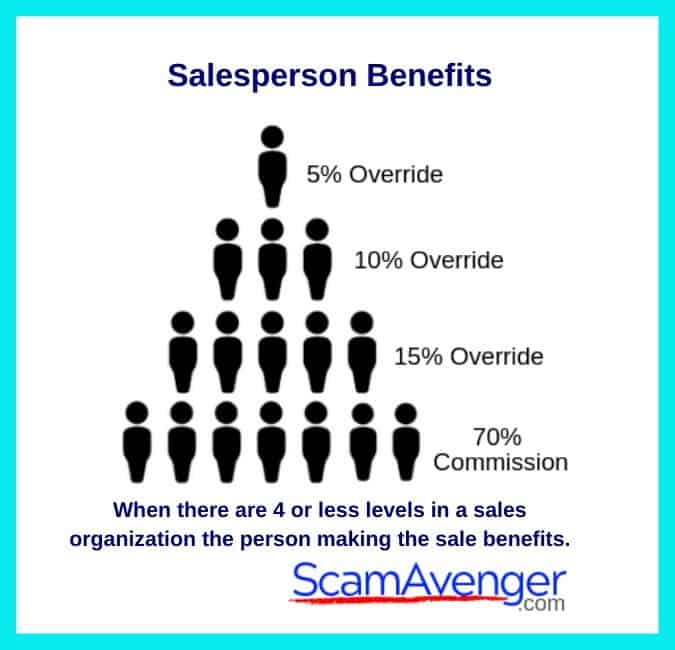
In a genuine direct marketing company, the salesperson earns most of the commission generated by a sale because there are only four levels at the most. With this arrangement, a salesperson can earn a full-time income, just making retail sales.
However, in MLM, the commission from a sale is divided among the upline. The more levels there are, the more the commission is dispersed. People at the top of the sales force earn a commission from thousands of people in the downline, although they had nothing to do with the sales.
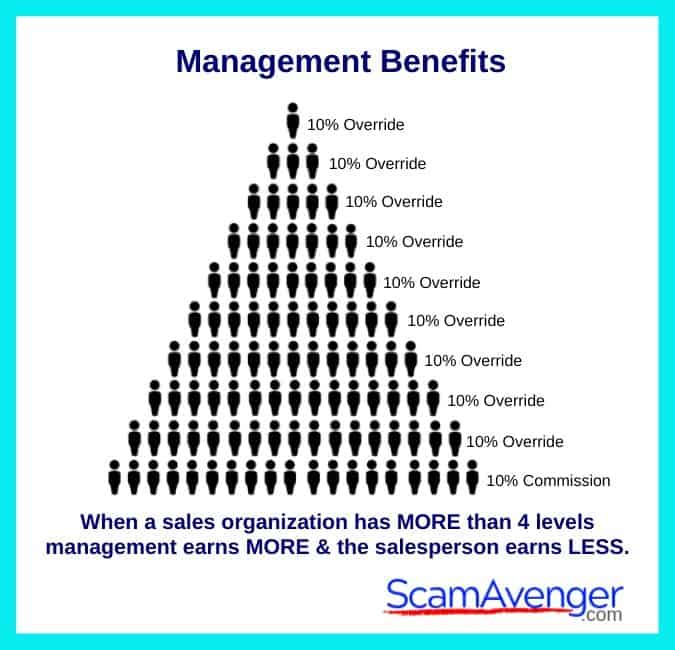
In an MLM, it is challenging for the salesperson to earn a full-time income because they get a much smaller slice of the commission. In they want to make a full-time income in MLM, they must build a downline.
Why MLM is a Lousy Business Model.
For the rank and file, success with an MLM company like Trades of Hope is nearly impossible.
True to the MLM industry, Trades of Hope discreetly encourages CEs to purchase products in large quantities. A practice MLM critics might consider product-loading. More on that in a moment.
While the company policy states a CE is not required to maintain an inventory, the compensation plan clearly shows incentives for purchasing a $1000 worth of product in the first 60 days and $300 worth of product every month after that.
To fully understand how sophisticated Trades of Hope is at exploiting their Compassionate Entrepreneurs, you must first understand the nature of MLM.
In the following sections, I discuss the MLM industry in sobering detail.

Why People Run from MLM.
Multi-level marketing is known for selling false hope to people who can least afford to be exploited.
MLM uses the promise of opportunity to lure people into their scheme. Ultimately, less than 1% of the people who try MLM earn a profit.
99% of the people chasing an MLM opportunity are really unwitting customers buying over-priced company products.
Truth be known, it’s the same with Trades of Hope.
There is no opportunity in MLM for the rank and file. The people who succeed with MLM are the people who own the company and a few who got in early.
The only other way to succeed with MLM is to fund your business out of pocket until you rise to the top of the sales organization. This may take years of struggle and tens of thousands of dollars.
And, in the end, all you’ve built is a business inside a business. You don’t control it, the company does.
Seeking Alpha, a website for investors reports that MLM is seen as unethical because requires endless recruiting while only rewarding the top 1% of the salesforce.

An article on the Vice website states that MLMs destroy people’s finances.
Combining the promise of making money with the appeal of a charity is pure genius. It’s how Trades of Hope can charge their CEs two hundred times what they paid for a piece of jewelry.
The dream of opportunity and helping mothers in poor countries can be extremely appealing. Once a person buys that dream, once they believe it, they might drive themselves into debt, trying to achieve it.
For most people, failure with MLM is inevitable.
Why People Lose Money with MLM.
MLM exploits the people it recruits.
It preys on the trust of its salesforce and their desire for a better life, while at the same time, taking their money and making their life worse.
Some people do make money with MLM, but it has never been as rewarding for the average person as promised. Trades of Hope is no different.
Here’s why most people lose money with MLM.
- The salespeople must pay for the privilege of selling the company’s products.
- The salespeople must buy products or pay a fee each month to “qualify” to sell the company’s products.
- MLMs front load new salespeople with products.
- MLM products are over-priced.
- MLM encourages salespeople to pressure family and friends.
- MLM is an antiquated business model requiring a lot of energy to earn a small return.
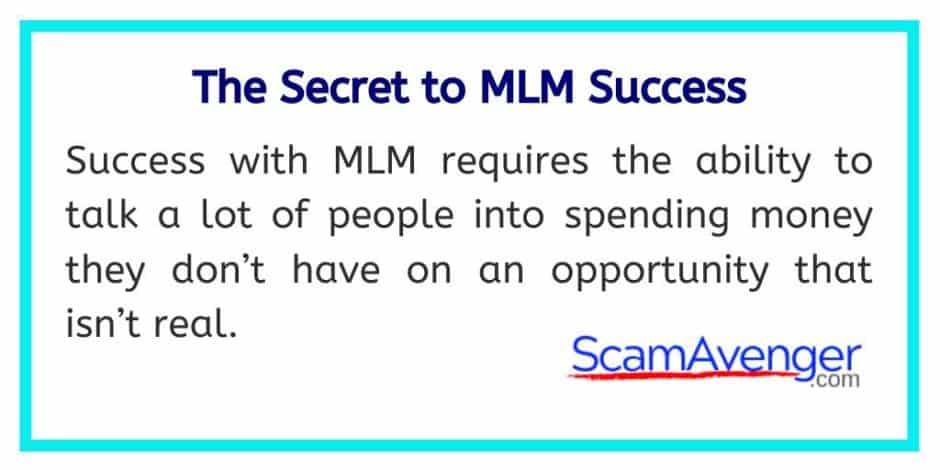
Front-Loading Products.
A typical MLM tactic is to load new salespeople with products. This is often called front-loading, product-loading, or inventory-loading. It’s incredibly profitable for the company.
Front-loading burdens a new salesperson with more products than they can reasonably sell. Usually, a new salesperson must charge the expense to a credit card, which further burdens them with debt.
Because front-loading exploits a new salesperson’s trust and vulnerability, it’s unethical.
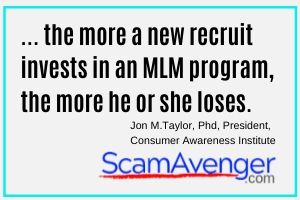
The Direct Selling Association Code of Ethics forbids front-loading and states, “Our members must…encourage salespeople to purchase reasonable levels of inventory.”
The word reasonable is open to interpretation.
Regarding Trades of Hope, I would say that $199 worth of costume jewelry is pressing the upper limits of reasonable and $1000 worth of the stuff of way beyond reasonable.
Yet, Trades of Hope leaves the door open for a new CE to buy a $1000 worth of products within 60 days of joining.
It’s not direct front-loading, the new CE might sell a $1000 worth of product instead, but there’s nothing to prevent them from charging it to their credit card either.
From Trades of Hope perspective, it makes no difference. The company earns a profit either way.
MLM’s Sad Joke.
The MLM business model is the opposite of good business practices. Because MLMs exploit their salespeople, the business is inherently unstable. It requires continuously recruiting new people into the organization.
When you join an MLM, you are led to believe you are building a business for yourself.

You may be called a distributor, an associate, or some other sophisticated title.
If you join Trades of Hope, you will be called a Compassionate Entrepreneur, but that isn’t a legal description.
In the Trades of Hope INDEPENDENT CONTRACTOR AGREEMENT, which you sign when you join, you are defined as a Direct Sales Consultant and legally considered to be an independent contractor.
But, because Trades of Hope controls your behavior and your revenue, you’re more like an unpaid employee. That’s the first part of the joke.
It gets worse.
As an independent contractor, you must pay all your own expenses, including buying products from Trades of Hope at marked-up prices. That’s the second part of the joke.
As we’ve seen, Trades of Hope requires salespeople who want to build a downline to “qualify” by either buying or selling $1000 worth of product in the first 60 days. And then “qualify” again by either buying or selling $300 worth of product each month.
Only in MLM is the salesforce expected to “qualify” to earn overrides. Doesn’t that strike you as odd?
If you can qualify each month by purchasing products, are you a salesperson, or are you a customer?
By requiring CEs to qualify, Trades of Hope creates a closed loop that benefits the company at the expense of the salesperson.
The Trades of Hope Hamster Wheel.
Qualifying each month can become like running on a hamster wheel.
According to the Trades of Hope Independent Contractor Agreement, if you fail to meet the Minimum Leadership Support Requirements, you will lose your downline. (See Roll-Ups in the Agreement)
What are the Minimum Leadership Support Requirements?
It’s mostly about actively helping your downline, but it also requires that you generate 300 PRV ($300) each month. If you fail to generate 300 PRV for a month, you will not earn overrides on your downline. If you fail to generate 300 PRV for six months, you lose your downline forever. (See Minimum Leadership Support Requirements in the Agreement)
In other words, you must perform each month or buy 300 PRV.
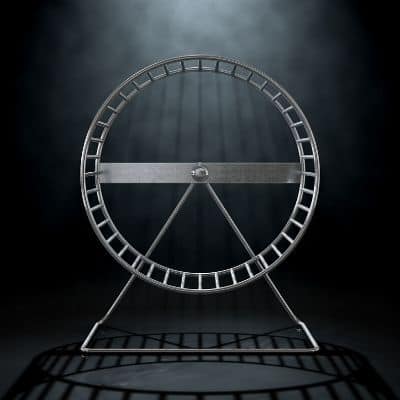
The Trades of Hope Agreement allows for maternity leave and an exemption for extenuating circumstances, but you must apply for them and be approved by the company as if you’re an employee.
Remember, you’re an independent contractor in business for yourself, but you’re controlled by Trades of Hope.
Trades of Hope Can Terminate You.
Consider this, Trades of Hope can terminate your agreement with the company at ANY TIME for ANY REASON. (See Home Office Termination in the Agreement).
The bottom line of the Trades of Hope Independent Contractor Agreement is you must perform, or you will be penalized.
As a minimum, Trades of Hope requires that you generate 300 PRV each month. The word “generate” is code for either sell that much or personally buy that much.
Brief Comparison of MLM and Affiliate Marketing.
For comparison, I’m an affiliate marketer. I own several websites that earn a comfortable living for me. They work 24/7 with very little attention.
I haven’t touched one of my websites in three years, and it continues to chug along, making money.
My entire online empire costs less than $100 a month and produces a comfortable full time income, plus leaves me plenty of free time to do other things.
With my affiliate marketing business, I don’t have to meet any silly “minimum performance requirements,” or buy products. And I darn sure don’t have to ask the company for permission to live my life.
If you’d like to see more reasons why affiliate marketing is better than MLM, read Why Affiliate Marketing is Better than MLM.
Don’t Trust the Trades of Hope Compensation Plan.
The Trades of Hope compensation plan is a “hypothetical” document.

In the Income Claims paragraph of the Trades of Hope Independent Contractor Agreement, we are told that the dollar figures in the compensation plan are “hypothetical.”
The Trades of Hope Compensation Plan is NOT a legal document.
The compensation plan is a marketing tool.
It’s purpose is to convince you that you can make money with the Trades of Hope opportunity. But there is NO real evidence to suggest you can make money with Trades of Hope.
The Trades of Hope Compensation Plan isn’t real!
Also, in the same Income Claims paragraph, Trades of Hope states that the Federal Trade Commission and the laws of several states require that an income disclosure be provided to prospective recruits but then, Trades of Hope doesn’t provide one!
However, there is no evidence anywhere than anyone is making money with Trades of Hope.
Without an Income Disclosure, which is a factual historical record of how much CEs earned, we are left to assume the worse.
Also, read the Income Claims paragraph in the Agreement, and you’ll see that CEs are not permitted to discuss how much they earn.
Many MLMs do publish an income disclosure. Why doesn’t Trades of Hope? Are the numbers too bad to reveal?
Is Trades of Hope a Pyramid Scheme?
Trades of Hope is not a pyramid scheme. It’s a direct selling company that uses a multi-level compensation plan. Most people who try multi-level marketing lose money.
Is Trades of Hope a Scam?
Trades of Hope is not a scam. It is a direct selling company with a multi-level compensation plan. Most people who pursue an MLM opportunity lose money. If you think you have been scammed by Trades of Hope, you can appeal to the Direct Selling Association.
Click to Discover a Proven Path to Financial Independence!
The Last Word on Trades of Hope.
The endless feel-good messages and images on the Trades of Hope website are a marketing smokescreen. Beneath the emotional messages of hope and empowerment you’ll find a highly sophisticated multi-level marketing company.

To truly understand the nature of Trades of Hope, you must ignore the feel-good marketing and thoroughly read and understand the Trades of Hope Independent Contractor Agreement.
Making money with Trades of Hope certainly appears possible through straight commissions, IF you know enough people willing to pay premium prices for costume jewelry and accessories.
However, continually finding parties may be a challenge. Once you begin building a downline, you will be faced with qualifying each month, which may get costly.
Ultimately, MLM is only profitable for the company and a few at the top, which either got in early or beat the odds and climbed through the ranks.
Then, of course, if you manage to build a Trades of Hope organization, the company can terminate you anytime for any reason and take away all you worked for. They make this option clear in the Agreement.
MLM is an antiquated business model from the middle of the 20th Century, nearly 100 years ago. The only reason it’s still around is that MLM is so darn profitable for the company.
We’re well into the 21st Century now. We have the internet.

If you’re searching for a real opportunity, the internet is it. Now anyone can open shop in the global marketplace where billions of dollars change hands every day.
With a little training, patience, and about $50 a month, you can build an affiliate marketing business that earns money 24/7.
Affiliate marketing is so much easier and profitable.
Read Why Affiliate Marketing is Better than MLM.
Related Posts:
- Premier Designs
- Paparazzi Accessories

- Is Univera a Good Opportunity?

